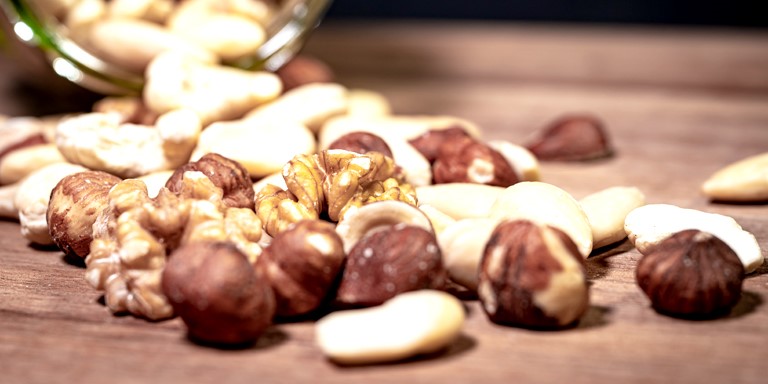Nut allergy
Approximately 10% of children and adults with a food allergy cannot tolerate nuts. Even traces of nut can be a problem.

Table of contents:
Almonds, hazelnuts and walnuts: children are especially prone to a primary nut allergy. Unlike other allergies, a nut allergy often does not resolve with age. And yet, most adults who experience itching in the mouth when they bite into a nut bar are more likely to have a secondary allergy, a cross reaction.
Triggers
The following hard-shelled fruits are botanically nuts and can trigger a nut allergy: cashew, hazelnut, macadamia nuts (Queensland nuts), almond, Brazil nuts, pecan nuts, pistachio and walnut.
Primary nut allergy sufferers typically have a reaction to the storage proteins in nuts. These are different from one type of a nut to another. But there is one thing they have in common – they cannot be destroyed either by heat or stomach acid, which means that they can cause allergic reactions in any form – whether raw, roasted or cooked. Depending on the severity of the allergy, care needs to be taken even with traces of nut.
Because the allergens of the different nuts are not the same, having an allergy to one nut does not automatically mean being allergic to all nuts. This is only very rarely the case. The allergy specialist can determine exactly which types of nut sufferers should also avoid. They can and should continue to eat any nuts that they can tolerate.
Presence
Nuts, and traces of nut too, are present in a wide variety of foods – sometimes not so obviously. They can be found not only in bakery products, such as bread, cakes and savoury snacks, in sweets, such as ice cream and snack bars, and in sandwich spreads but also in ready meals and much more besides. Purchasing guide in German «Einkaufshilfe Nussallergie».
Course of the allergy
Primary nut allergies are likely to first occur in childhood. For most sufferers it is a lifelong allergy. If the nut allergy first occurs during adolescence or in adulthood, it is typically a secondary allergy, or cross allergy. The sufferers are really allergic to birch or grass pollen but also have a reaction to the food due to the similarity of the allergens. This allergy is often milder than the primary allergy. More about cross-reactions.
Symptoms
As with all other food allergies, nut allergy symptoms appear within minutes and to an hour after consumption and typically include itching in the mucous membranes of the mouth and on the skin with redness, wheals and swelling. Like other food allergies, respiratory symptoms may also occur. Isolated gastrointestinal symptoms are rare. They usually occur in combination with other allergy symptoms, such as difficulty swallowing, nausea, vomiting, diarrhoea and bloating. In rare cases, the allergy may result in anaphylactic shock with breathing difficulties and circulatory collapse.
Diagnosis
Self-monitoring – ideally recorded in a symptom diary – and a consultation with an allergy specialist, together with the results of skin and blood tests, are the essential basis for the diagnosis of nut allergy. To confirm the diagnosis and to determine the tolerance level, provocation (or challenge) tests may also be required.
Treatment
Strict avoidance of the food causing the allergy is essential. It is also essential to watch for concealed sources in bakery products, sausage, spice blends and semi-cooked and ready meals. If there is a risk of an anaphylactic reaction, it is essential to strictly avoid even the tiniest amounts (traces / contaminants). Whether traces can be tolerated should be decided by an allergy specialist. They may use a provocation or challenge test to determine the level of tolerance to the allergen.
A specialist dietician can provide helpful support in implementing treatment in daily life. For example, to learn how to read ingredient lists, to receive practical advice and to discuss possible changes to one’s personal daily life.
Anyone who has already suffered a severe allergic reaction should always carry an emergency medical ID card and an emergency kit to ensure prompt treatment of any further severe allergic reaction. In any event, once first aid has been administered, they should then seek medical attention from an emergency doctor or hospital.
Labelling of food
The presence of nuts in food must be declared in Switzerland and the EU. This means that the ingredient and any products produced from it are clearly labelled and highlighted on the packaging – for example, in bold type, italics or in capital letters. Unintentional mixtures/ combinations must also be mentioned at the end of the list as follows: “may contain …” or “may contain traces of …”. Sales staff in shops selling food (e.g. bakeries, butcher’s etc) and in restaurants, takeaway kiosks etc must also provide information. By law, information supplied verbally by a professional is adequate
Tips and tricks
- Write the allergy-causing foods on a “visiting card” and hand to restaurant staff when ordering.
- Before holidays, have these cards translated into the local language and take them with you.
- When invited round to friends and family, either tell the hosts exactly about your allergy or offer to take something allergen-free with you.
- Check lists of ingredients of familiar foods before buying. The recipes can be changed at any time. If you are not sure, the manufacturers or wholesalers will be glad to provide information. Their contact details can be found on the packaging.
- When shopping, look out for products with the Allergy Seal of Quality, these are particularly suitable for people with allergies and intolerances and are recommended by aha! Swiss Allergy Centre.
Facts and figures
Nuts, including hazelnuts, cashew nuts and walnuts, are common triggers of food allergy and anaphylaxis in children. As nut allergy is often lifelong, nuts are often also major triggers of allergy and anaphylaxis in adults.
Nut allergy: FAQs
Must I give up nuts for the rest of my life if I have a nut allergy?
The chances of outgrowing an allergy to specific nuts are small compared to other allergies. The specific type of nut, and in severe allergies even traces of the nut, must be avoided for the whole of one’s life.
Must I give up all nuts if I have a nut allergy?
allergy specialist can determine exactly which types of nut sufferers should also avoid. Depending on the severity of the allergy, care needs to be taken even with traces of nut. Sufferers can and should continue to eat any nuts that they can tolerate.
Must I also give up peanuts if I have a nut allergy?
No, as, botanically, peanuts are not nuts but legumes. However, it is possible for someone who has a nut allergy to develop a peanut allergy as well. This should be discussed with an allergy specialist.
Why do coconuts, peanuts, pine nuts, tiger nuts and butternut squash have nothing to do with nuts although they have similar names?
None of these foods are botanically hard-shelled fruits. However, allergies to all these foods can also occur, but independently of a nut allergy.
Eating out: what should I watch out for?
Food can become contaminated with hard-shelled fruit when hard-shelled fruit is also used in the same place, for example, in factories, at the butcher’s, at ice-cream kiosks or in kitchens. Unfortunately, this is almost always the case. For this reason, eating out is not recommended if you have a very severe nut allergy.
Editors: aha! Swiss Allergy Centre in co-operation with the Scientific Advisory Board.

